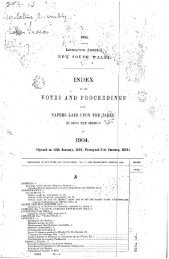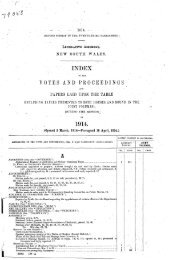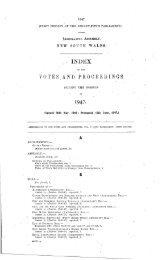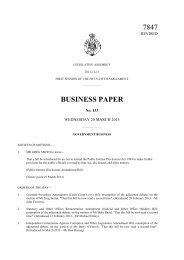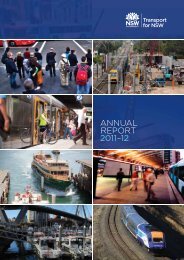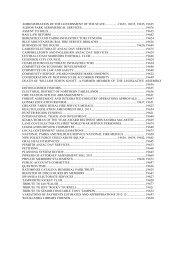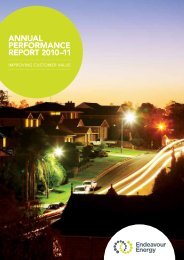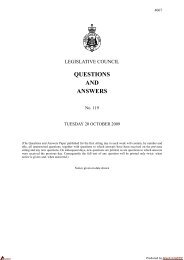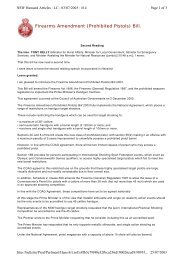Questions & Answers Paper No. 158 - Parliament of New South ...
Questions & Answers Paper No. 158 - Parliament of New South ...
Questions & Answers Paper No. 158 - Parliament of New South ...
Create successful ePaper yourself
Turn your PDF publications into a flip-book with our unique Google optimized e-Paper software.
7056<br />
LEGISLATIVE ASSEMBLY QUESTIONS AND ANSWERS<br />
MONDAY 12 OCTOBER 2009<br />
The revision <strong>of</strong> administrative processes has led to improved systems for the monitoring <strong>of</strong> attendance,<br />
for referral processes to specialist support and better communication with parents. These processes<br />
include:<br />
• daily monitoring <strong>of</strong> rolls and by period in secondary school;<br />
• letters home to parents each week about unexplained absences;<br />
• personalised attendance plans developed and referrals made to Home School Liaison Officers<br />
and⁄or the Learning Support Team where appropriate;<br />
• Mobility Trackers submitted each term by the school to be investigated by the Home School<br />
Liaison Officer to account for all students enrolled in the school;<br />
• refined registration process <strong>of</strong> late arrivers including the implementation <strong>of</strong> the Late Interview<br />
Program (LIPS); and<br />
• reviewed processes for transition between classes with Secondary and Primary.<br />
In Walgett for example, new processes have been developed for tracking the whereabouts <strong>of</strong> students<br />
who fail to attend school. A Phone Intervention Program, which provides early contact with parents and<br />
carers when students are absent from school, has been implemented in Walgett and Bourke.<br />
These schools are implementing a range <strong>of</strong> intervention strategies to promote attendance which includes<br />
the development <strong>of</strong> personalised attendance plans, developed with students and parents, to address the<br />
particular needs <strong>of</strong> individual students. They continue to undertake home visits and to provide rewards<br />
for students with excellent attendance.<br />
In addition, school staff and police work co-operatively on Joint Attendance Strategy operations. An<br />
Attendance Mentor position has been established to work with students with attendance difficulties at<br />
Walgett.<br />
Curriculum enhancements are targeted at the key success factors <strong>of</strong> literacy and numeracy skills. The<br />
schools are implementing the Reading to Learn strategy, a research-based approach which has already<br />
proven successful in improving student outcomes in literacy.<br />
Aboriginal language programs have been implemented.<br />
A new approach to teaching in ways appropriate to Aboriginal students, the "8 Ways <strong>of</strong> Knowing", is<br />
being implemented in all three communities.<br />
Other strategies include:<br />
• a major curriculum restructure in Walgett where a middle school has been established to improve<br />
the transition from primary to secondary education;<br />
• access for students in Bourke and Brewarrina to the Girri Girri Sports Academy, a program<br />
designed to build confidence and engagement with school through sport for secondary students<br />
with poor attendance;<br />
• access to a wide curriculum delivered on site or through distance technologies; and<br />
• access to vocational education courses as part <strong>of</strong> their senior curriculum.<br />
All schools in Walgett, Brewarrina and Bourke aim to work closely with their communities to improve<br />
the educational outcomes for students. This includes working with other government and nongovernment<br />
agencies and working closely with groups such as local Aboriginal Education Consultative<br />
Groups to develop strategies which can be supported across the entire community to promote attendance<br />
and engagement.<br />
*7373 INDIGENOUS TO NON-INDIGENOUS RATIO—Mr Kevin Humphries asked the Minister for<br />
Education and Training, and Minister for Women—<br />
(1) What is the ratio <strong>of</strong> indigenous to non-indigenous students who attend the following schools:<br />
(a) Moree East Primary;<br />
(b) Courallie High;<br />
(c) Mungindi Central;<br />
(d) Moree Primary;<br />
(e) Collarenebri Central;<br />
(f) Walgett Primary;<br />
(g) Walgett Secondary;<br />
(h) Brewarrina Central;<br />
(i) Bourke Primary;<br />
(j) Bourke High;<br />
(k) Coonamble Primary;<br />
Produced by Alts<strong>of</strong>t Xml2PDF



